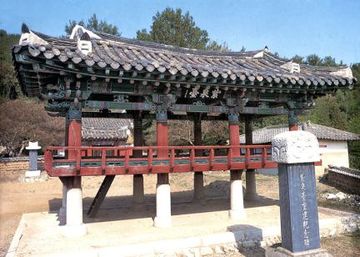"자천대"의 두 판 사이의 차이
(→영문) |
(→영문) |
||
| 31번째 줄: | 31번째 줄: | ||
'''Jacheondae Pavilion''' | '''Jacheondae Pavilion''' | ||
| − | + | This pavilion, built in 1967, commemorates a legend about Choe Chi-won (857-?), a scholar and writer of the Unified Silla period (668-935), who is said to have enjoyed reading at a pavilion atop a rock called Jacheondae, which overlooks today's Haje Port around 9 km to the southwest of this location. The name Jacheondae means "Platform of the Red Pond," as it is said there was a lotus pond situated next to the rock which always had a reddish tone. | |
| − | + | According to a legend, there were two stone jars next to the pavilion atop Jacheondae Rock inside which Choe Chi-won had hidden secret documents. Whenever the stone jars were dragged and moved, a rainstorm would immediately come in from the sea. Therefore, in times of drought, hundreds of locals would gather and drag the jars with large ropes in order to make it rain. However, whenever a foreign envoy would visit this area, they would go to see the stone jars on Jacheondae, which was uncomfortable for the locals. So, the locals demolished the pavilion and buried the two stone jars. | |
| − | + | '''Other than this legend, there are no records about the original pavilion that once stood atop Jacheondae Rock. A pavilion, likely not the original lived in by Choe Chi-won, is said to have been torn down at the site in the late period of the Joseon dynasty (1392-1910), corroborating the legend.''' In 1934, the local magistrate Choe Hak-su built a new pavilion at Jacheondae Rock to commemorate the site. At some unknown later point, the 1934 pavilion was moved to the premises of Okguhyanggyo Local Confucian School and then replaced with the current building in 1967. | |
===영문 해설 내용=== | ===영문 해설 내용=== | ||
2020년 11월 16일 (월) 12:50 판
| 자천대 Jacheondae Pavilion |
|
 자천대, 국가문화유산포털, 문화재청. |
|
| 대표명칭 | 자천대 |
|---|---|
| 영문명칭 | Jacheondae Pavilion |
| 한자 | 紫泉臺 |
| 주소 | 전라북도 군산시 옥구읍 광월길 33-50 (상평리) |
| 지정(등록) 종목 | 전라북도 문화재자료 제116호 |
| 지정(등록)일 | 1984년 4월 1일 |
| 분류 | 유적건조물/주거생활/조경건축/누정 |
| 수량/면적 | 1동 |
| 웹사이트 | 자천대, 국가문화유산포털, 문화재청. |
|
|
|
해설문
국문
자천대는 통일신라 말기의 문장가 최치원(崔致遠, 857~?)이 당나라에서 돌아와 노닐며 독서했던 누각이라 전한다. 자천대라는 이름은 바위산 옆의 연못이 항상 붉어서 붙은 이름이다.
원래 이 누각은 옥구군 선연리 하제포구의 작은 바위산 위에 있었다. 그러나 조선 후기에 허물었고, 1934년 옥구군수 최학수가 지역 유림의 뜻을 모아 다시 세웠다. 이후 옥구향교가 있는 이곳으로 옮겼다. 지금의 건물은 1967년에 다시 지은 것이다.
전설에 따르면 자천대에는 두 개의 돌 항아리가 있었는데 최치원이 태수를 지낼 때 항아리 안에 비밀문서를 감춰 두었다고 한다. 돌 항아리를 끌어당겨 움직이면 바다에서 갑자기 비바람이 몰아쳤기 때문에 가뭄이 들면 주민 수백 명이 큰 밧줄로 항아리를 끌어당겨 비를 불렀다고 한다. 하지만 사신들이 옥구에 올 때마다 이러한 모습을 구경하였기 때문에 백성들이 힘들어하자 정자를 허물고 돌 항아리도 땅에 묻었다고 한다.
영문
Jacheondae Pavilion
This pavilion, built in 1967, commemorates a legend about Choe Chi-won (857-?), a scholar and writer of the Unified Silla period (668-935), who is said to have enjoyed reading at a pavilion atop a rock called Jacheondae, which overlooks today's Haje Port around 9 km to the southwest of this location. The name Jacheondae means "Platform of the Red Pond," as it is said there was a lotus pond situated next to the rock which always had a reddish tone.
According to a legend, there were two stone jars next to the pavilion atop Jacheondae Rock inside which Choe Chi-won had hidden secret documents. Whenever the stone jars were dragged and moved, a rainstorm would immediately come in from the sea. Therefore, in times of drought, hundreds of locals would gather and drag the jars with large ropes in order to make it rain. However, whenever a foreign envoy would visit this area, they would go to see the stone jars on Jacheondae, which was uncomfortable for the locals. So, the locals demolished the pavilion and buried the two stone jars.
Other than this legend, there are no records about the original pavilion that once stood atop Jacheondae Rock. A pavilion, likely not the original lived in by Choe Chi-won, is said to have been torn down at the site in the late period of the Joseon dynasty (1392-1910), corroborating the legend. In 1934, the local magistrate Choe Hak-su built a new pavilion at Jacheondae Rock to commemorate the site. At some unknown later point, the 1934 pavilion was moved to the premises of Okguhyanggyo Local Confucian School and then replaced with the current building in 1967.
영문 해설 내용
자천대는 통일신라시대의 학자이자 문장가였던 최치원(857~?)이 독서하던 곳이라고 전해진다.
원래 이 누각은 옥구군 선연리 하제포구의 작은 바위산 위에 있었다. 자천대라는 이름은 이 바위산의 이름으로, 바위산 옆 연못빛깔이 항상 붉어 붙인 '붉은 연못가의 바위산'이라는 뜻이다. 1934년 옥구군수 최학수가 다시 세웠고, 이후 옥구향교로 옮겼으며, 지금의 건물은 1967년에 다시 지은 것이다.
전설에 따르면 자천대에는 두 개의 돌 항아리가 있었는데 최치원이 항아리 안에 비밀문서를 감춰두었다고 한다. 돌 항아리를 끌어당겨 움직이면 바다에서 갑자기 비바람이 몰아쳤기 때문에 가뭄이 들면 주민 수백 명이 큰 밧줄로 항아리를 끌어당겨 비를 불렀다. 하지만 사신들이 옥구에 올 때마다 가서 구경하였기 때문에 백성들이 괴로워졌고, 이에 정자를 허물고 돌 항아리도 땅에 묻었다고 한다.
참고자료
- 자천대, 『디지털군산문화대전』
- 자천대, 문화재청 국가문화유산포털
- 옥구 상평리 자천대, 국립문화재연구소 문화유산 연구지식포털